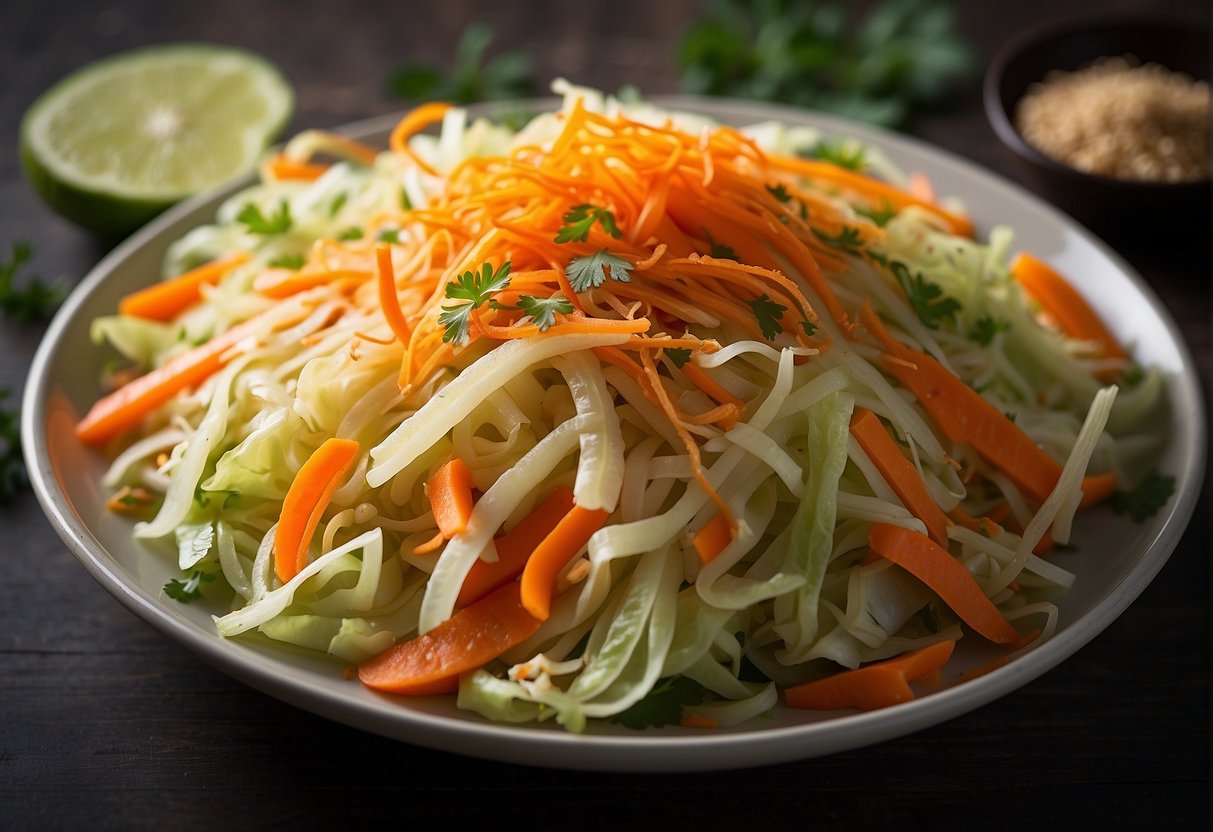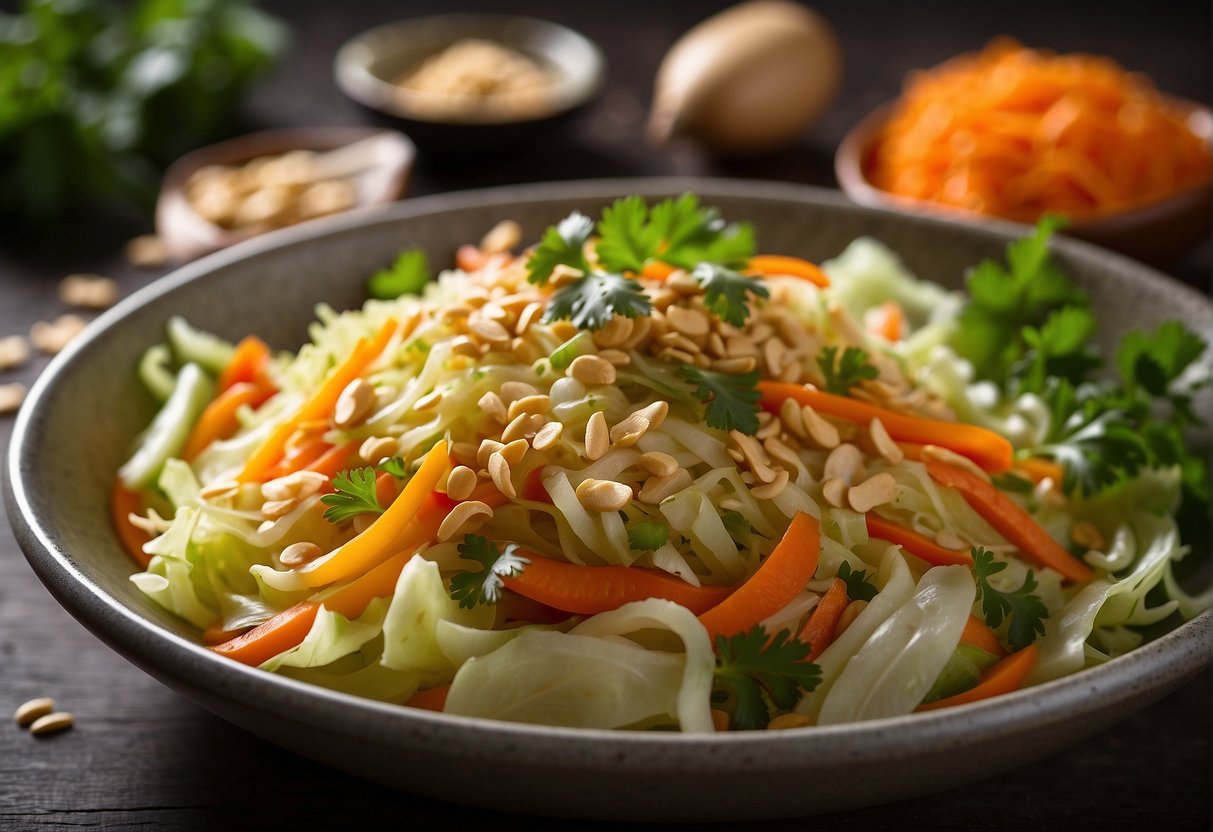Thai-style coleslaw, also known as Thai slaw or Asian cabbage salad, is a refreshing and vibrant side dish that perfectly complements a variety of main courses. This delicious and easy-to-make salad is characterized by its unique blend of sweet, tangy, and fresh flavors, with an influence from the culinary traditions of Thailand and other Southeast Asian nations.
Incorporating a mix of ingredients like cabbage, carrot, mint, cilantro, and sometimes kohlrabi, this slaw is dressed with a delightful combination of lime juice, sugar, fish sauce, chili, and coconut milk. This dressing not only imparts a bold and tantalizing taste but also accentuates the crisp and crunchy textures of the vegetables used. Enjoy Thai-style coleslaw at your next gathering or meal, and discover for yourself how simple it is to prepare and how truly satisfying it can be on your palate.
Origins and Significance

Thai Cuisine Influence
Thai-style coleslaw, also referred to as Thai slaw or Asian slaw, is a refreshing spin on the traditional coleslaw. This dish combines classic Thai flavors with the basic structure of coleslaw, resulting in a unique and delicious side dish. Thai cuisine, known for its use of bold and exotic flavors, heavily impacts the taste of this coleslaw variation. Common ingredients in Thai slaw include:
- Fresh herbs, such as cilantro and mint
- Lime juice
- Fish sauce or soy sauce
- Ginger
- Garlic
- Peanuts
- Spicy elements, like chili peppers or sriracha
These flavors beautifully enhance the crunchy texture of the cabbage and other vegetables, while the dressing keeps the dish light and tangy.
Coleslaw Variations
Original coleslaw has its roots in the 18th century Netherlands, where it was called “koolsla” (meaning cabbage salad). The traditional version typically consists of thinly sliced cabbage, vinegar or a vinaigrette, and seasonings. However, as this dish has evolved and spread globally, there have been numerous variations and adaptations.
These include:
- American-style coleslaw: Features a creamy, mayonnaise-based dressing
- Coleslaw with vinaigrette: Often includes a tangy vinaigrette in place of mayonnaise
- Asian slaw: Incorporates a mix of thinly sliced cabbage, carrots, and other vegetables, flavored with an Asian-inspired dressing
- Thai slaw: A unique combination of Thai cuisine flavors, fresh herbs, and the crunchy vegetables traditionally found in coleslaw
Through the years, coleslaw has proven to be a versatile dish, with diverse variations reflecting different cultural traditions and preferences. Thai-style coleslaw is a testament to coleslaw’s adaptability, merging the flavors of Thai cuisine with the familiar structure of a cabbage salad, offering a delightful and inventive side dish to enjoy.
Key Ingredients

Vegetable Components
Thai-style coleslaw incorporates a variety of colorful and crunchy vegetables to create a refreshing salad. Green cabbage, red cabbage, or Savoy cabbage can be used as the primary component for a classic coleslaw mix. Add carrots and kohlrabi for additional texture, color, and natural sweetness. Red bell peppers are an optional choice to include. Complement these vegetables with a blend of aromatic herbs, such as cilantro and green onions, to bring depth and freshness to your coleslaw.
Dressing Essentials
The dressing is what brings the Thai-style coleslaw together by infusing it with bold flavors. Some essential ingredients to create the perfect dressing include:
- Lime juice: Providing acidity and a citrusy touch.
- Fish sauce: Enhancing umami and saltiness.
- Soy sauce: Alternatively, for an extra savory note and color.
- Sugar: To balance the flavors with a hint of sweetness.
- Sesame oil: Adding a toasty, nutty aroma.
- Coconut milk: For a rich, creamy mouthfeel.
- Peanut butter: To provide a smooth texture and nutty flavor.
- Spice: Include some heat via chilies or hot sauce, based on your preference.
Feel free to combine these elements according to your taste preferences. Once your dressing is ready, toss everything together and garnish with chopped peanuts for a crunchy finish. This Thai-style coleslaw adds a delightful twist to your traditional coleslaw and will be a hit at your next meal or gathering.
Nutritional Profile
Caloric and Macronutrient Breakdown
Thai-style coleslaw is a nutritious and flavorful salad that provides a well-rounded macronutrient profile. On average, a serving of Thai-style coleslaw (approximately 1 cup) contains:
- Calories: 180
- Protein: 5g
- Carbohydrates: 12g
- Fiber: 3g
- Sugars: 6g
- Fat: 12g
- Saturated fat: 2g
Keep in mind that these values may vary depending on the ingredients used and portion sizes.
Vitamins and Minerals
Thai-style coleslaw is not only rich in macronutrients but also provides a variety of essential vitamins and minerals that contribute to overall health. Below is a summary of some key nutrients found in this dish:
| Vitamin / Mineral | Amount / % Daily Value |
|---|---|
| Vitamin C | 45% |
| Calcium | 5% |
| Iron | 5% |
| Potassium | 8% |
| Sodium | 10% |
This delicious and crunchy salad is an excellent source of vitamin C, which plays a critical role in maintaining a healthy immune system and healthy skin. It also contains small amounts of essential minerals such as calcium and iron, which contribute to bone health and red blood cell formation, respectively. Finally, the potassium content in Thai-style coleslaw can help balance sodium levels and support healthy blood pressure.
However, pay attention to the sodium content, which can be higher depending on the ingredients used, such as in the dressing or added seasonings. Make sure to adjust the recipe and ingredient choices accordingly to meet your personal dietary needs and preferences.
In conclusion, Thai-style coleslaw packs a nutritional punch with its blend of fresh ingredients, satisfying various macronutrient and micronutrient needs. Enjoy this wholesome and flavorful salad without compromising on taste or nutrition.
Preparation Techniques
Dressing Preparation
To prepare the Thai-style coleslaw dressing, start by combining essential ingredients such as lime juice, sugar, and fish sauce in a small mixing bowl. Let this mixture sit for about 10 minutes to allow flavors to meld. In the meantime, mince 1 large garlic clove and 1 teaspoon of fresh ginger. Add these to the liquid mixture along with soy sauce and sesame oil. Whisk in coconut milk to create a smooth and creamy dressing. For additional flavor depth, you can also mix in freshly chopped cilantro.
Vegetable Cutting and Mixing
For the coleslaw main ingredients, select a mix of colorful and crisp vegetables. A combination of shredded green and red cabbage, as well as julienned carrots and thinly sliced bell pepper, is ideal. Add these to a large mixing bowl.
Once the dressing is ready, pour it over the vegetables, tossing gently to distribute the dressing evenly. Be cautious with the amount of dressing you add, ensuring it doesn’t overwhelm the vegetables. You can adjust the quantity to suit your taste preferences.
For the perfect finish, here’s a list of optional garnishes to elevate your Thai-style coleslaw:
- Chopped fresh cilantro for a burst of fresh flavor
- Crushed or chopped salted peanuts for added texture and crunch
- Extra lime wedges for a tangy boost at the table
To assemble, simply layer the garnishes on top of the dressed coleslaw and serve. Your vibrant Thai-style coleslaw is now ready to impress your family or guests with its bold flavors and refreshing crunch!
Serving Suggestions
Accompaniments
Thai-style coleslaw makes a fantastic side dish and complements a variety of main courses. Here are a few options to serve with your Thai-style slaw:
- Grilled meats: Serve your coleslaw alongside grilled chicken, beef, or pork at your next BBQ, making it a delicious addition for both paleo and non-paleo guests.
- Fish dishes: Many Thai dishes feature fish sauce, and your Thai slaw can add a refreshing balance to fish entrees.
- Vegetarian options: If you’re catering to vegetarians, consider adding tofu or tempeh as a protein-rich option. Alternatively, bulk up your Thai slaw by mixing in rice noodles or cooked quinoa for a more substantial serving.
To customize your Thai-style slaw, consider adding these toppings:
- Roasted peanuts for a tasty crunch
- Fresh herbs such as cilantro or mint
- A dash of lime juice for extra zing
Presentation Tips
To ensure your Thai-style coleslaw looks as good as it tastes, follow these presentation tips:
- Plate it up: Use a wide, shallow serving dish to showcase the vibrant colors and textures of your slaw.
- Keep it neat: When arranging your slaw, use tongs or a large fork and spoon to gently toss and transfer servings onto the plate, avoiding unnecessary mess.
- Garnish: Add visual appeal by sprinkling roasted peanuts, fresh herbs, or a drizzle of fish sauce (if desired) on top of your slaw.
Remember, meal prep can also impact the presentation of your Thai-style slaw. Prepare the dressing ahead of time, and mix it with the coleslaw ingredients closer to serving. This will keep your slaw looking fresh and prevent it from becoming soggy.